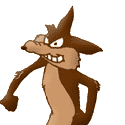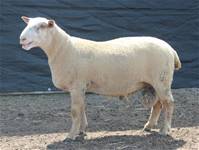
|
|
The Numbers Game
It finally happened. After all these years raising sheep, and over a dozen years raising registered purebreds, I bumped into a numbers person who tried to convert me. Don’t get me wrong, over the years I have dealt with several Canadian Arcott breeders who rely pretty heavily on numbers, indexes, and technology. But, keep in mind that these breeders are running pretty large flocks; they rely on technology to track each ewe, and to find the poor performers so they can be culled out. Mostly, they just have too many ewes to be able to do it all on paper and by memory. Many of these breeders are in Quebec, where they also have conformation scores done on their rams, so that even if they don’t really have an eye, or have lost their eye because they have come to rely too heavily on their GenOvis indexes, the conformation score should put them back on track for soundness, proper conformation, and detecting flaws that exclude a ram from the breeding pool. And what about me, how do I do it? Well, I am also enrolled in GenOvis. Over the years, occasionally this topic has come up on social media, and I invariably get asked, “What have you got against GenOvis?” Well, nothing. The problem is not GenOvis itself, it is how some breeders use it. As for myself, I only have about 80 Canadian Arcott ewes. I am not in the business of buying ewes much anymore, we usually buy two or three a year if we attend a sale such as the All Canada Classic, to support other breeders that we feel are raising good sheep, and to heck with how they did in the show. I haven’t bought a ram in years. (Many breeders take this personally, but it’s all about the lines they’re using, it’s not personal at all.) I currently have 11 rams for my own use plus one in the tank. So yes, these sheep have GenOvis data available. Do I look at it? Absolutely. Do I share it? I certainly do, and on the Canadian Arcott page of our website, I post the numbers, as stated there, “warts and all”. Good, bad, or indifferent, I post the GenOvis data for anyone to see. I don’t care if a ram’s Gain is in the 16th percentile. He was selected based on his structure, soundness, conformation, length, thickness, bone, muscle, how he travels, and yes, growth (but I don’t need GenOvis to tell me how he grew, I can throw the lamb on the scale for that), as well as pedigree, and possibly scrapie genotype. If he was unsound, had crooked legs or bad feet or an ugly topline, if his mouth was off, if he was a runt, he wouldn’t be here. I don’t need GenOvis to tell me he was a runt, and furthermore, GenOvis can’t tell me if his mouth is off, if his legs are crooked, if his loin is too narrow, etc. Use that GenOvis data if you want, but for heaven’s sake look at your sheep. This, in my humble opinion, is what is wrong with how GenOvis is used by some breeders. The breeder who tried to convert me, I can’t really say what their aim was. You can’t convert me onto GenOvis, I am already enrolled in it. First, they tried to convert me to using software (Ewe Manage, specifically, because it is compatible with Genovis), because I freely admitted I still keep records old school (pen and paper). Now, again, don’t take me the wrong way- judging by this breeder’s inventory on the CLRC website, they probably have around 200 females. Also, I believe this breeder also works off farm (though I believe it is their spouse that actually does the lion’s share of the sheep work, and whether they work off farm I have no idea). So naturally a software program is a godsend for them. But I, with 80 ewes, and a true passion for this breed, don’t need a software program. The majority of the history of each ewe is already in my personal data base (my brain), and what I forget I can very quickly look up. In fact, I would prefer to keep my old school method. Writing things down forces you to assimilate them into your body of knowledge. And on the fly, out in the sheep pen, what difference does it make if I look it up in a day timer or on my phone? It amounts to the same thing in the end. This debate, however, is one of those, “Let’s agree to disagree” things that we will both just have to accept. You do it your way and I will do it my way and in the end, if we are both happy, what does it matter? But (and it’s a really big but)- we then proceeded to have a discussion about using GenOvis data for selection. We were discussing indexes and percentiles, and I told them that we select the animal first, then we look at the numbers, which just happen- they are what they are. Honest to goodness, they looked at me like I had a second nose growing out the side of my head. I wish I was exaggerating, but alas, I am not. I then repeated to them something that I have on one of the listings on my web page- “A crap lamb with good numbers is still crap. And a good lamb with crap numbers is still a good lamb.” I thought their head would explode. Here's the thing, gentle reader (I am sure there really is only one)- this person actually told me that the good lamb with crap numbers has no genetic merit. I mean, how do you arrive at this conclusion? The lamb is a phenomenal lamb, he is standing right in front of you and you can see it with your own eyes, and you can put your hands on him and feel it with your own hands, but because the GenOvis data tells you he’s no good, he’s no good??!! I asked them, what if their numbers are low because there is data missing on the ancestors? They came from a flock with no GenOvis data? Another question I could have asked them- what if the lamb was injured or lame for a time? Their growth tanked. Now he is the best ram in the pen. You must not have blinders on when you look at those numbers! What’s even worse, look at the inverse of this situation. Someone presents you with their lamb with sky-high GenOvis numbers, and tells you he is their best. He is hump-backed, his feet turn under, his loin is short, he travels badly, his rear pasterns are spongy. You can see with your own eyes and feel with your own hands that this is not a ram you would use. But to them, he is their best. How did we get here? I have said it before and I’ll say it again- breeding livestock is both an art and a science. But here is the thing about the science- if I take it away, can you still breed sheep? Picture this- all sheep breeders have all that technology taken away from them. You have nothing to rely on but your own eyes and hands, your knowledge of your animals, their history, their pedigree, etc. You select rams based on what you see in front of you, and based on traits that you are trying to set or improve in your lambs. You select lambs from your lamb crop the same way. You have replacements ewe lambs, ewe lambs for sale, and rams to sell, based on what is standing in front of you, how they grew, how they travel, and if they look like the kind of sheep you are trying to produce. Just like the breeders who created all these breeds in the first place! Now, what if we do it the other way around? You are blindfolded and have your hands tied behind your back. You let an IT person go through your indexes and percentiles, and they select your animals. Not just the rams you will buy to use, but their lambs next year. Based solely on numbers. Now, imagine that the very top ram throws all kinds of problems, like the ones listed above. But his lambs have great GenOvis numbers (because they grow well, and because he has great GenOvis numbers), so you select most of them to keep and to sell. And it doesn’t even have to be a serious problem, but it can be a trait change that creeps up on you over the generations. Specifically what I am referring to is what I am seeing myself in some of these consistently high-numbered sheep, and that is a long, lanky, shallow-bodied frame on ever-lengthening legs. This scares me, because if you start producing these lanky, long-legged sheep consistently, pretty soon, because of their great GenOvis numbers, you are going to start believing that is what the best ones look like. And I am wiling to bet they are seeing similar trends in other breeds. So- this is where the art comes in. If you can have all that data taken away, and you can still select, breed, retain, sell, and, most importantly, improve, then you are an artist. I suggest you can have the art without the science, but you can’t have the science without the art and still improve, or even maintain what you started with. So yes, I am enrolled in GenOvis. I look at those numbers, I find them interesting. Mostly what interests me is 1) how lambs in a cohort group compare, 2) how lambs in a sire group compare, and 3) how the numbers change over time as animals have more progeny. But I could certainly keep doing what I’m doing if you took it all away tomorrow. But please do not try to convert me to selecting based on numbers alone. I believe that is a huge mistake and I will not fall prey to it. Updated:7/28/2025 |



